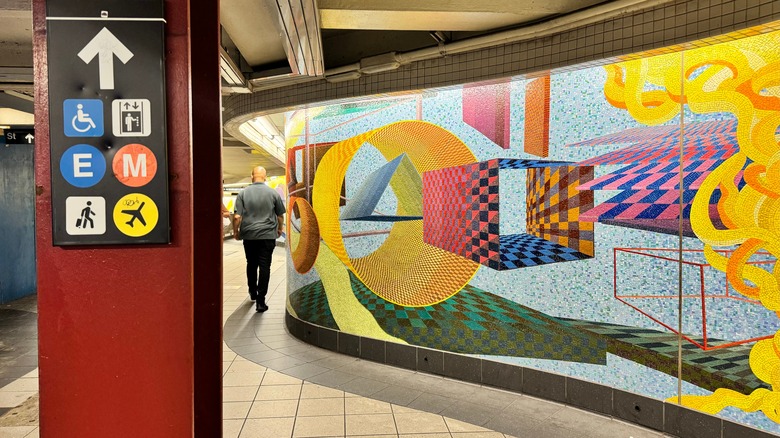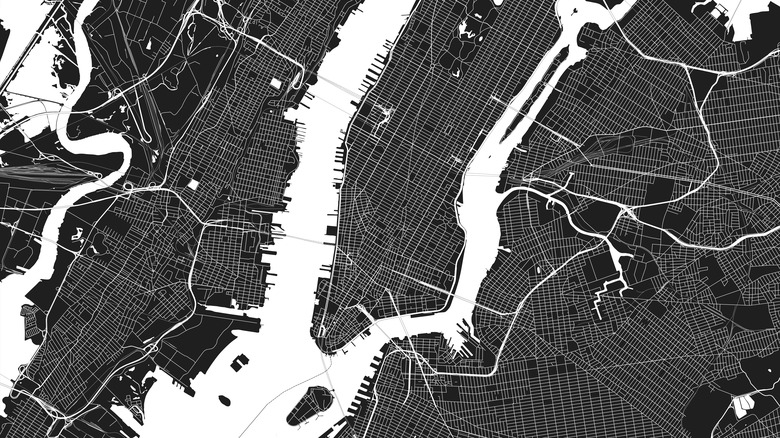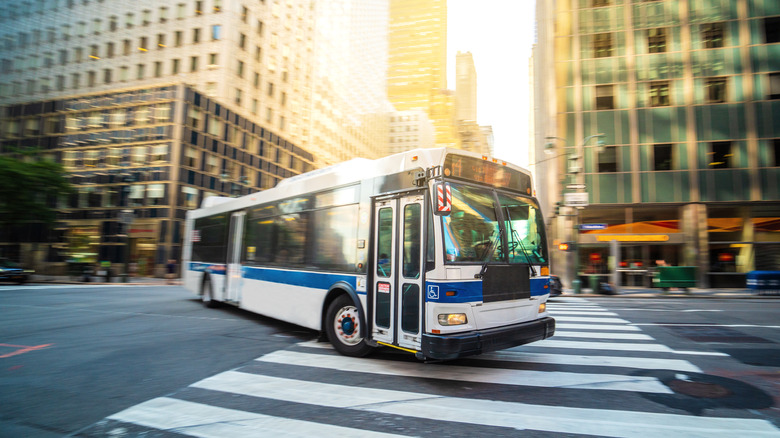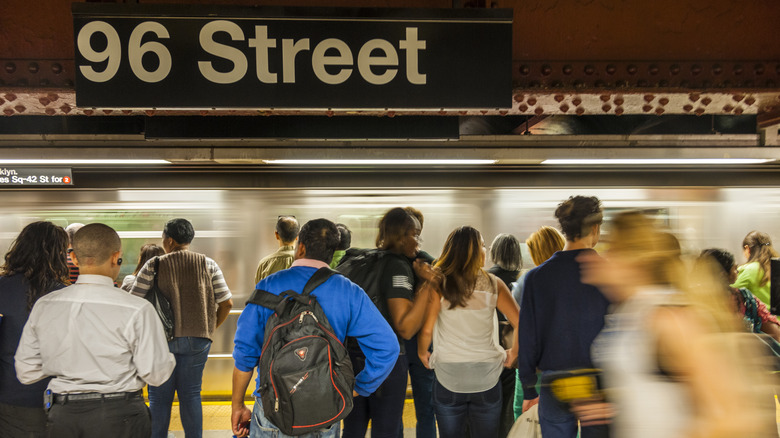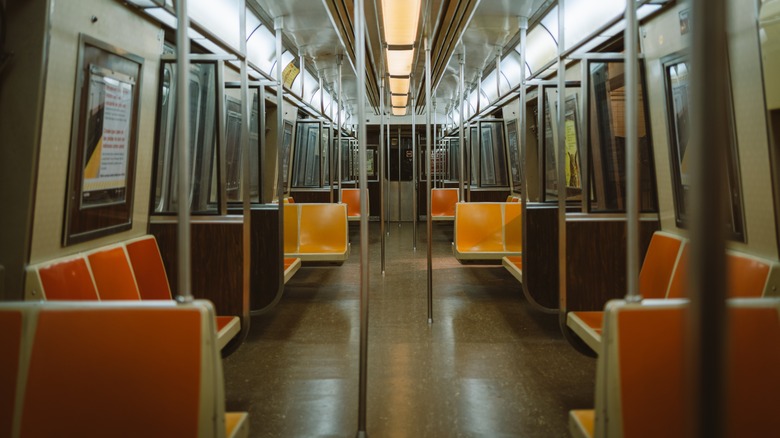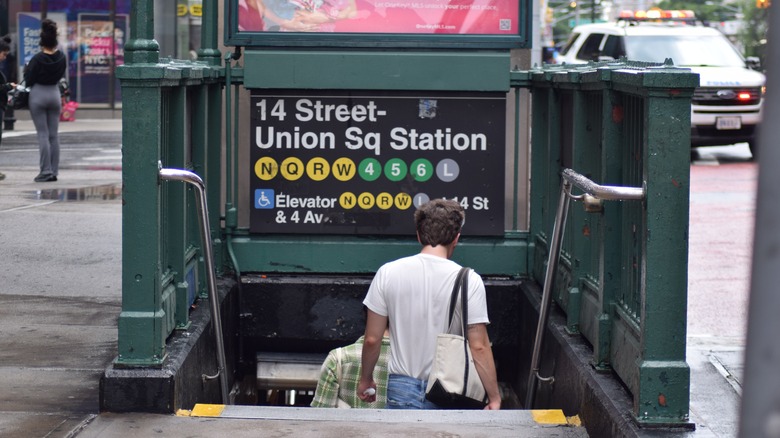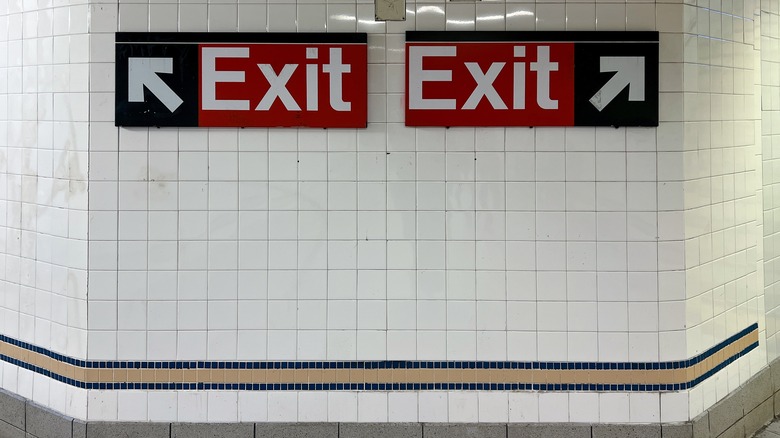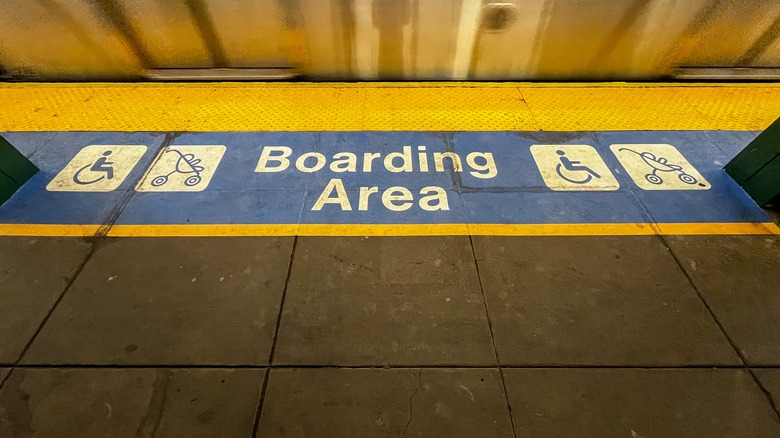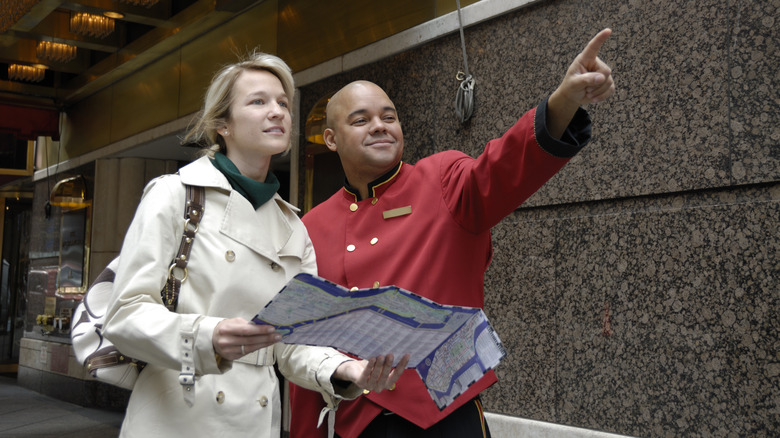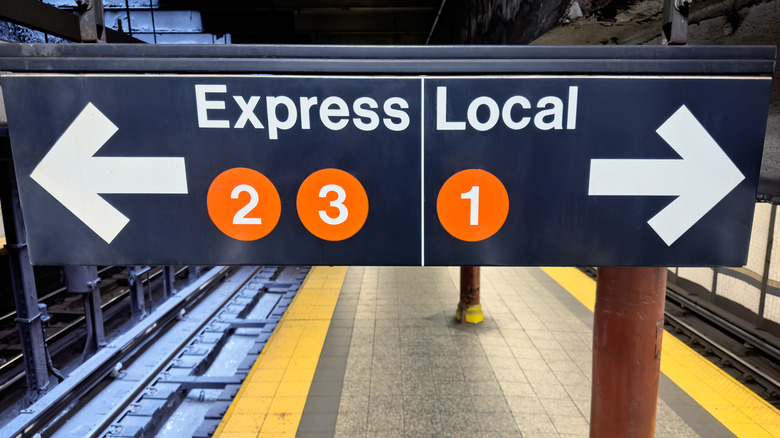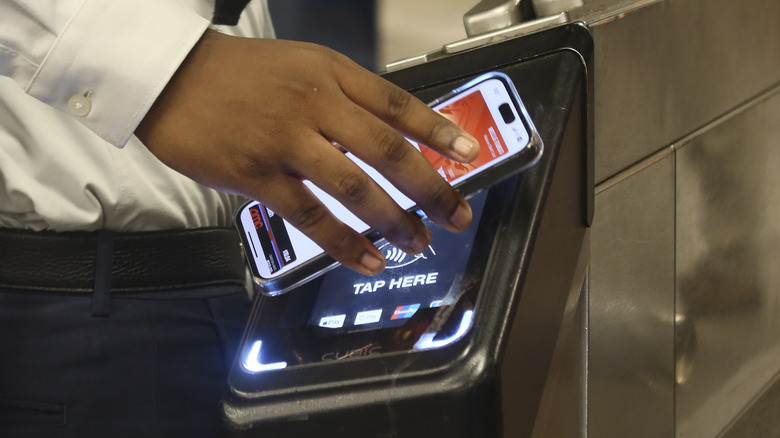A Visitor's Guide To New York City's Chaotic Subway System
The New York City subway system, operated by the Metropolitan Transport Authority (MTA), is something of a legend in the realm of public transportation. It has been in operation since 1904, and since then, it has grown to encompass 665 miles of track. Barring natural disasters and public emergencies, the subway buzzes with life 24/7, even on holidays. On it, you'll find students, workers, residents, and tourists commuting around a city that spans roughly 469 square miles.
However, for the first-time rider (and even for those who have visited NYC a few times), the subway system may not be the most intuitive. With a rainbow of train lines referred to by both numbers and letters, it takes some practice to understand how to find your way. Even with apps that tell you which trains to take, it can be difficult to locate the correct entrances and board trains going in the correct direction. To help make your travels smoother and more enjoyable, here are some tips to better navigate New York City's chaotic subway system, based on our experience in the city that never sleeps.
Learn NYC's geography before studying the subway map
Because trains are often identified by the borough or neighborhood to which they are going, it is critical to study a map of NYC before using the subway. NYC has five boroughs: The Bronx, Manhattan, Queens, Brooklyn, and Staten Island. The Bronx is the northernmost borough, and below it lies Manhattan. East of Manhattan is Queens, and south of Manhattan is Brooklyn (both on Long Island). Finally, Staten Island is southwest of Brooklyn, and you must take a ferry or drive across the Verrazano-Narrows Bridge to get there.
Most tourists gravitate toward Manhattan, which is divided into three overarching regions. Upper Manhattan generally refers to the city north of 59th Street. It includes Central Park, the Museum Mile, and Harlem, the underrated New York neighborhood that is a history-rich, foodie paradise. Midtown starts around 34th Street and ends at 59th Street. It contains many buildings and locations depicted on postcards, like the Empire State Building, Broadway, and Times Square. Several large transfer stations, like Times Square-42 Street and Grand Central-42 Street, are in Midtown.
Lower Manhattan is south of 34th Street and is home to areas like the Financial District, SoHo, and Chinatown. Understanding a train's direction of travel is easiest when it is labeled as "uptown" or "downtown." Sometimes, however, directions are indicated by street names (like Euclid Avenue) or landmarks (like Brighton Beach), and you may need a map to understand if it is the correct train for you.
Know what the subway is, as well as what the subway is not
If you're flying into the Big Apple, don't expect to board the subway immediately. You'll need to first take a bus, a taxi, JFK Airport's AirTrain, or Newark Airport's AirTrain in conjunction with a New Jersey Transit train to connect you to the subway system. From there, the opportunities are endless.
Many of NYC's 472 functioning subway stations are subterraneous, but plenty can be found above ground as well, especially outside the heart of Manhattan, where there is (slightly) more space. The 36 lines of NYC's subway system form an intricate web that spans all five boroughs and can connect you to the previously mentioned New Jersey Transit system, as well as the Amtrak train system, the Long Island Railroad (LIRR), the Metro-North Railroad, and the Port Authority Trans-Hudson (PATH) system. These services require separate tickets but allow you to explore areas outside the city, like the Adirondacks and Northport, the family-friendly New York town that is a beautiful, uncrowded alternative to the Hamptons.
While buses are not part of the subway system, you can transfer from the subway to a local bus (or vice versa) for free, so long as your MetroCard swipes or OMNY taps fall in the same two-hour window. This also applies to transferring between local buses. If boarding an express bus, you must pay the fare difference (the only exception being if you hold a 7-Day Unlimited Express Bus Plus MetroCard).
Avoid rush hour as much as possible
As you might imagine, New York City rush hours can get ugly. And yes, that is "hours" in the plural. Route planning service Circuit found that the average NYC car commuter spends 236 hours in peak traffic each year, and we ranked NYC as one of the five worst cities for finding parking in all of America. That congestion above ground is mirrored by unbelievably packed subway cars underground: according to the MTA, total annual ridership was 1.15 billion in 2023 (about 3.6 million per day). Most subway stations are not air-conditioned, so in the summertime, when temperatures can reach 100 degrees Fahrenheit, you might be holding your breath and squirming amidst seas of sweating passengers.
Nobody likes crowds, so avoid rush hours by trying not to travel between 6 a.m. and 9 a.m. or 4 p.m. to 7 p.m. According to the MTA, the Times Sq-42 Street/Port Authority Bus Terminal was the busiest subway station in 2023, followed by Grand Central-42 Street and 34 St-Herald Square. Taken together, these Midtown stations service nearly all the major lines, so even if you board a relatively empty subway car in Brooklyn, be prepared to shift your bag to your lap and make room for other passengers the further you travel into Manhattan (making space for others is one of the best transportation tips to blend in like a local in New York City).
Be wary of empty cars
In a city with legions of pedestrians, hotel rooms barely large enough to fit a bed, and grocery stores that are inevitably packed with bumper-to-bumper pushcart traffic, we get it: You'll likely find yourself desperate for some personal space. But if you descend into a crowded subway station, don't hold your breath hoping for a miraculously empty car. Such cars are usually empty for a reason.
In fact, whatever you do, don't trust an empty subway car in New York City. It might have a broken air conditioning unit, or there might be a strange, unidentifiable substance that has spilled across the floor from one end of the car to the other. You never know what might be the reason for an empty car on an otherwise packed train, and sometimes, it's simply best not to find out.
There's another reason you might want to opt for the company of other people: Safety. Especially at night, board a car towards the center of the train near the conductor, who can help keep you safe and give you directions as needed. This safety measure can be reassuring for anyone, even seasoned New Yorkers.
Know which entrance you need to take
If you're in a rush or know that the train you want to take will soon be leaving, it can be tempting to descend into a station and swipe your card without double-checking that you are on the correct side of the street. However, boarding a train heading in the wrong direction can spell disaster. In most cases, you'll have to exit and re-enter the subway, though some stations have bridges over the tracks that allow you to access the correct train. Larger transfer stations, like Times Sq-42 Street, are also designed so that a flight of stairs is all that separates you from not only the train going in the other direction but also other lines.
Even so, if you find yourself at a smaller station without such amenities, an error in judgment can cost you the money required to re-enter the subway and also precious time. For example, if you are using an Unlimited Ride MetroCard, you must wait 18 minutes before re-entering. The exception to this rule is where free out-of-system transfers are provided, as is the case between the Junius Street and Livonia Avenue stations in Brooklyn, the Lexington Avenue/59 Street and Lexington Avenue/63 Street stations in Manhattan, and other stations during construction projects. Take the time to learn what phrases like "uptown" and "Queens-bound" mean, then look for them on signs. When unsure, ask for help from a pedestrian or shopkeeper before entering the subway.
Know which exit you need to take
Where you board the train will determine where you exit the train. Many subway stations have surprisingly long platforms that can equate to the length of several city blocks. Navigation apps will typically tell you the exit you need to take, but making your way to the correct exit can be a nuisance if you are short on time.
It may be more peaceful and a better use of your time to stroll the length of the platform while awaiting your train than to hustle the same distance alongside a crowd at your destination. If traveling the same route several times during your stay, you will quickly learn which cars to board. Regardless of when you cover the distance, it will be faster to walk underground than above ground, where traffic lights and construction projects will likely impede your progress. However, if you have time and want to soak in more of the scenery, feel free to leave the station at the nearest exit.
If you plan to exit at the 145 Street station, the trains are too long for every car to open onto the platform. The conductor will announce this station several stops in advance and advise you to make your way to the first five cars if you plan to exit. Try boarding one of these cars in advance to avoid frantically dashing between cars and trying to figure out if you are in one of the first five.
Download the free NYC subway app
Closures and delays are a given on the subway. After all, the system is 120 years old and often needs repairs and renovations, including the introduction of accessible features (more on that below). That's why using a transportation application — like the official MTA app — is more practical than working with a map alone. It will suggest routes, notify you of train arrivals, and help you plan more complicated journeys that may involve bus transfers. You can download the MTA app from the Apple Store or Google Play.
Additionally, the station you are stopping at is not always indicated inside older trains, and it can be difficult to see around passengers and pillars to locate signs in the stations themselves. Now that Wi-Fi is provided for free at all subway stations, using the MTA app while en route is a breeze. After you connect to the Wi-Fi network at one station, your phone will remember it for every other station. That way, you can quickly check your route when your train stops to ensure you are still on the right path.
Not all stations are accessible
If you or any of your travel companions are on wheels, pushing a stroller, carrying a bicycle, or have luggage in tow, note that nearly three-quarters of subway stations are not considered accessible and may not have ramps or elevators to accommodate your needs. Even when such facilities do exist, they are not always easily located and can be at the far end of walkways. Accessible stations are denoted by wheelchair symbols on the MTA's official subway map.
Frequently, some lines in a station will be accessible while others are not, and that is noted accordingly. Train conductors or automatic recordings will announce when you are approaching an accessible station, and some trains have overhead displays that provide relevant information regarding upcoming stations. Accessible stations also have boarding areas reserved for those with disabilities. They are typically near where the conductor's car will stop and where the gaps between trains and platforms have been modified to be minimal. If you are on the C line and board one of the new R211A trains, you can count on wider doors, more accessible seating, and open gangways for easier movement between cars.
When traveling with children, be proactive to avoid unnecessary headaches. If you have a baby, use a baby sling or carrier that attaches to your body. If you have a small child, use a travel stroller that collapses quickly and compactly and can be carried up and down stairs.
Don't be afraid to ask for help
Although New Yorkers are often concise in their interactions with strangers, they are usually quite willing to help. There are multiple opportunities to seek assistance when using the subway. Of course, always use common sense when talking with strangers to protect yourself from pickpockets while traveling.
Unless it's the middle of the night in a quiet neighborhood, you will find pedestrians roaming the streets. If you are having trouble locating a station, don't hesitate to ask for help. Locals will usually point you in the right direction without needing to pull out a map.
After descending below street level (but before you pass through the turnstiles), you will see a ticketing desk at each station where an MTA employee can answer questions. Whether you need assistance figuring out your route or are having difficulty adding money to your subway card, this employee will have the answers you need for a smoother subway experience. Once on the train, you can ask the conductor for help. However, this may require you to find them, which could take the duration of several stops and, therefore, set you back a substantial amount of time if you are going in the wrong direction or miss a transfer. Instead, ask a fellow passenger for assistance. Maps are posted in some — but not all — subway cars; if a New Yorker sees you scrutinizing one, they will frequently offer help.
Know the difference between express and local
Depending on the time of day you travel, you will encounter express and local trains. Express trains are just what they sound like: They get you to your destination faster, but only if your destination is one of the stations marked by a white circle on the MTA's official map. A white circle means that both express and local trains stop at that station. When a station is marked by a black circle, that means only local trains stop there.
Because local trains stop at every station on the line, sometimes letting a local train pass and boarding an express train that comes a few minutes later can be more time-efficient, as the latter will soon overtake the former. These trains would usually be of different numbers; for example, a local 1 train vs. an express 2 train. The 6 and 7 lines are special cases, where express and local trains can run simultaneously; express trains for these lines are denoted by diamonds and local trains by circles.
Look to platform signs for information on the days and times that specific lines will have an express service. In general, evening service usually turns express trains into local trains. Even local New Yorkers will ask conductors for assistance in finding the best route when such changes happen unexpectedly.
Get familiar with OMNY in advance
Since it rolled out in 2019, the OMNY system has gradually been replacing the MetroCard system. OMNY is relatively easy to use; simply tap an OMNY card (available for purchase at pharmacies throughout the city), credit/debit card, wearable device, or smartphone with digital wallet to the readers outside turnstiles. OMNY can save you a significant sum of money, as it features an automatic weekly fare cap: After your 12th subway ride in one week, every subsequent ride is free until the following week. This weekly fare cap is available with the MetroCard system as well, but you have to pay for it upfront, running the risk of not riding the subway enough to meet the cost of investment.
You can use the same OMNY payment method for yourself and up to three other riders, which is useful when traveling with children. However, the system only allows you to do so if you have used that payment method before. If you are traveling with very small children, you will be delighted to hear that as many as three children shorter than 44 inches can travel with you on the subway, free of charge.
OMNY is also designed to accommodate Reduced Fare benefits, which allows those with qualifying disabilities, as well as senior citizens 65 years and older, to ride at 50% of the regular fare. Eligible riders must apply for Reduced Fare and then access their benefits by using either OMNY or a Reduced-Fare MetroCard.
